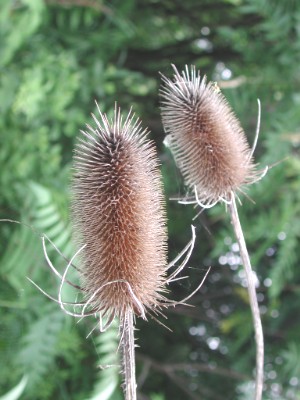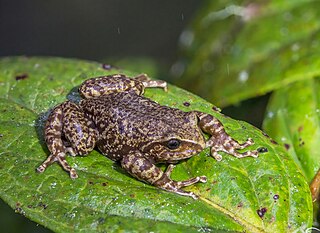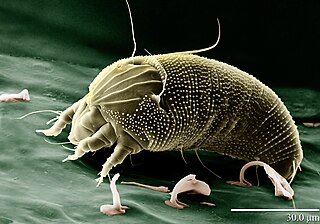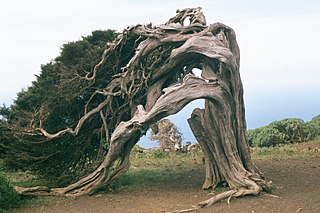
The Dipsacaceae were recognized as a family of the order Dipsacales containing 350 species of perennial or biennial herbs and shrubs in eleven genera. It was published by Antoine Laurent de Jussieu in his book Genera plantarum on page 194 in 1789.

Scabiosa is a genus in the honeysuckle family (Caprifoliaceae) of flowering plants. Many of the species in this genus have common names that include the word scabious, but some plants commonly known as scabious are currently classified in related genera such as Knautia and Succisa; at least some of these were formerly placed in Scabiosa. Another common name for members of this genus is pincushion flowers.

Linaria is a genus of almost 200 species of flowering plants, one of several related groups commonly called toadflax. They are annuals and herbaceous perennials, and the largest genus in the Antirrhineae tribe of the plantain family Plantaginaceae.

Lomelosia caucasica, the Caucasian pincushion flower, pincushion-flower or Caucasian scabious, is a species of flowering plant in the family Caprifoliaceae, native to the Caucasus, north eastern Turkey, and northern Iran. Growing to 60 cm (24 in) tall and broad, it is a clump-forming perennial with grey-green, divided leaves. Pincushion-shaped buds, borne on erect hairy, stems, open to pale blue or lavender flower heads, 4–8 cm (2–3 in) in diameter, from late summer through to autumn.

Calyceraceae is a plant family in the order Asterales. The natural distribution of the about sixty species belonging to this family is restricted to the southern half of South America. The species of the family resemble both the family Asteraceae and the Dipsacaceae.

Oreobates is a genus of frogs in the family Strabomantidae. Most species were formerly in the genus Ischnocnema, but were moved to this revalidated genus following a 2006 revision. Its sister taxon is Lynchius.

Pristimantis is a very large genus of frogs distributed in the southern Caribbean islands and in Central and South America from Honduras to northern Argentina and southern Brazil. With 596 described species, the genus had more species than any other genus of vertebrate animals. Many of these species genus are endemic to the Northwestern Andean montane forests ecoregion in north-western South America.

Aceria is a genus of mites belonging to the family Eriophyidae, the gall mites. These tiny animals are parasites of plants. Several species can cause blistering and galls, including erineum galls. A few are economically significant pests, while others are useful as agents of biological pest control of invasive plants such as rush skeletonweed, creeping thistle, and field bindweed.

Aceria guerreronis, the coconut mite, is an eriophyid mite which infests coconut plantations. It is economically devastating, and can destroy up to 60% of coconut production. The immature nuts are infested and injured by mites feeding in the portion covered by the perianth of the immature nut.

Aceria anthocoptes, also known as the russet mite, rust mite, thistle mite or the Canada thistle mite, is a species of mite that belongs to the family Eriophyidae. It was first described by Alfred Nalepa in 1892.
Aceria clianthi is a species of mite belonging to the family Eriophyidae. It is found only in New Zealand. It is notable for being host specific to threatened plants of the genus Clianthus. It is classified by Buckley et al. as "nationally critical" under the New Zealand Threat Classification System. They stated "Aceria clianthi (Eriophyidae), has been recorded only from kakabeak in cultivation and once on Lotus cornalatus [Lotus corniculatus] (Fabaceae), an introduced plant growing near kakabeak. It is given the same threat classification as kakabeak ." Heenan had earlier stated that "the two species [of Clianthus] are considered to be threatened, with C. maximus having a rank of vulnerable, whereas C. puniceus is critically endangered", but the conservation status of C. maximus was subsequently found to be more serious. These threat classifications for Clianthus apply to plants in the wild, but the species are widely cultivated. Aceria clianthi occurs on both plants in the wild and in cultivation.

Aceria tosichella, commonly known as the wheat curl mite (WCM), is a global cereal pest and a vector for spreading and transmission of viruses like wheat streak mosaic virus (WSMV) and wheat mosaic virus (WMoV)
Eriophyes tulipae, commonly known as the dry bulb mite, is a species of mite in the genus Eriophyes. This mite feeds on members of the lily family, and has damaged garlic crops. At one time, it was also thought to feed on wheat and other grasses, but the wheat curl mite is now regarded as a different species, Aceria tosichella.
Paleontology or palaeontology is the study of prehistoric life forms on Earth through the examination of plant and animal fossils. This includes the study of body fossils, tracks (ichnites), burrows, cast-off parts, fossilised feces (coprolites), palynomorphs and chemical residues. Because humans have encountered fossils for millennia, paleontology has a long history both before and after becoming formalized as a science. This article records significant discoveries and events related to paleontology that occurred or were published in the year 2015.

Aceria nervisequa is a species of mite that belongs to the family Eriophyidae. It is found in Europe and was first described by Giovanni Canestrini in 1891. The mite causes galls on the leaves of beech,

Aceria campestricola, is a species of mite in the family Eriophyidae. The mite causes galls on the leaves of elms and was described by Georg Ritter von Frauenfeld in 1865.

Lomelosia is a genus of flowering plant in the family Caprifoliaceae and the subfamily of Dipsacoideae. The genus includes over 50-63, perennial and annual species, diffused around the Mediterranean Sea, with the greatest diversity of species concentrated in the eastern Mediterranean and the Middle East, and also has a few species reaching as far east as China.

Juniperus canariensis is a woody plant in the family Cupressaceae native to the Canary Islands and Madeira, off the coast of Northwestern Africa.













